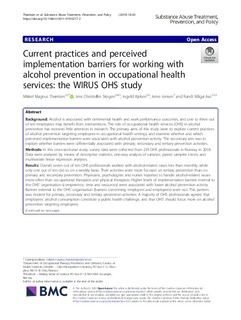| dc.contributor.author | Thørrisen, Mikkel Magnus | |
| dc.contributor.author | Skogen, Jens Christoffer | |
| dc.contributor.author | Kjeken, Ingvild | |
| dc.contributor.author | Jensen, Irene | |
| dc.contributor.author | Aas, Randi Wågø | |
| dc.date.accessioned | 2019-07-02T11:43:51Z | |
| dc.date.available | 2019-07-02T11:43:51Z | |
| dc.date.created | 2019-06-17T21:54:03Z | |
| dc.date.issued | 2019-06 | |
| dc.identifier.citation | Thørrisen, M.M., Skogen, J.C., Kjeken, I. et al. (2019) Current practices and perceived implementation barriers for working with alcohol prevention in occupational health services: the WIRUS OHS study. Substance Abuse Treatment, Prevention, and Policy, 14(30) | nb_NO |
| dc.identifier.issn | 1747-597X | |
| dc.identifier.uri | http://hdl.handle.net/11250/2603194 | |
| dc.description.abstract | Background
Alcohol is associated with detrimental health and work performance outcomes, and one to three out of ten employees may benefit from interventions. The role of occupational health services (OHS) in alcohol prevention has received little attention in research. The primary aims of this study were to explore current practices of alcohol prevention targeting employees in occupational health settings, and examine whether and which perceived implementation barriers were associated with alcohol prevention activity. The secondary aim was to explore whether barriers were differentially associated with primary, secondary and tertiary prevention activities.
Methods
In this cross-sectional study, survey data were collected from 295 OHS professionals in Norway in 2018. Data were analysed by means of descriptive statistics, one-way analysis of variance, paired samples t-tests, and multivariate linear regression analyses.
Results
Overall, seven out of ten OHS professionals worked with alcohol-related cases less than monthly, while only one out of ten did so on a weekly basis. Their activities were more focused on tertiary prevention than on primary and secondary prevention. Physicians, psychologists and nurses reported to handle alcohol-related issues more often than occupational therapists and physical therapists. Higher levels of implementation barriers internal to the OHS’ organisation (competence, time and resources) were associated with lower alcohol prevention activity. Barriers external to the OHS’ organisation (barriers concerning employers and employees) were not. This pattern was evident for primary, secondary and tertiary prevention activities. A majority of OHS professionals agreed that employees’ alcohol consumption constitute a public health challenge, and that OHS’ should focus more on alcohol prevention targeting employees.
Conclusions
Occupational health settings at workplaces may be particularly serviceable for alcohol prevention programmes since the majority of the population is employed and the majority of employees consume alcohol. An increase in overall prevention activity, and a shift from mainly focusing on tertiary prevention to an increased emphasis on primary and secondary prevention, may both hinge on increased training of OHS professionals, emphasising knowledge on the importance of working with alcohol prevention, and training in administering alcohol prevention programmes. Making alcohol prevention a priority may also require increased allocation of time and resources. | nb_NO |
| dc.language.iso | eng | nb_NO |
| dc.publisher | BioMed Central | nb_NO |
| dc.relation.uri | https://rdcu.be/bHTt4 | |
| dc.rights | Navngivelse 4.0 Internasjonal | * |
| dc.rights.uri | http://creativecommons.org/licenses/by/4.0/deed.no | * |
| dc.subject | rus | nb_NO |
| dc.subject | alkoholbruk | nb_NO |
| dc.subject | alkoholbruk i arbeidslivet | nb_NO |
| dc.subject | forebygging | nb_NO |
| dc.subject | occupational health services | nb_NO |
| dc.title | Current practices and perceived implementation barriers for working with alcohol prevention in occupational health services: The WIRUS OHS study | nb_NO |
| dc.type | Journal article | nb_NO |
| dc.type | Peer reviewed | nb_NO |
| dc.description.version | publishedVersion | nb_NO |
| dc.rights.holder | © The Author(s). 2019 | nb_NO |
| dc.subject.nsi | VDP::Medical disciplines: 700::Health sciences: 800 | nb_NO |
| dc.source.volume | 14 | nb_NO |
| dc.source.journal | Substance Abuse Treatment, Prevention, and Policy | nb_NO |
| dc.source.issue | 30 | nb_NO |
| dc.identifier.doi | 10.1186/s13011-019-0217-2 | |
| dc.identifier.cristin | 1705481 | |
| dc.relation.project | Norges forskningsråd: 260640 | nb_NO |
| cristin.unitcode | 217,13,1,0 | |
| cristin.unitname | Avdeling for folkehelse | |
| cristin.ispublished | true | |
| cristin.fulltext | original | |
| cristin.qualitycode | 1 | |

